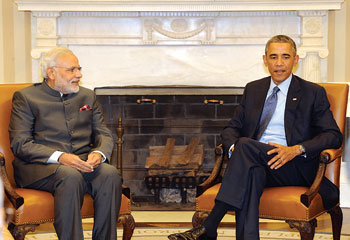INDIAN ARMED FORCES CHIEFS ON
OUR RELENTLESS AND FOCUSED PUBLISHING EFFORTS

SP Guide Publications puts forth a well compiled articulation of issues, pursuits and accomplishments of the Indian Army, over the years

I am confident that SP Guide Publications would continue to inform, inspire and influence.

My compliments to SP Guide Publications for informative and credible reportage on contemporary aerospace issues over the past six decades.
- Prime Minister witnesses 'Bharat Shakti' – a Tri-Services Firing and Manoeuvre Exercise in Pokhran, Rajasthan
- Interim Defence Budget 2024-25 — An Analysis
- Union Defence budget 2024
- Prime Minister Modi Commemorates Indian Navy Day in a Grand Ceremony
- Prime Minister Modi Flies in the LCA Tejas
- New Chapter in India-Italy Defence Ties
- Airpower beyond Boundaries
Strengthening bilateral relations

The invitation to President Barack Obama to visit India in January is a measure of the significance India puts on its strategic partnership with the United States. Prime Minister Narendra Modi has very publicly signaled a reshaping of India’s foreign policy and in particular policy towards the US. It also is a defining moment in bilateral relations as this is the first time that a President of the US will be Chief Guest at India’s Republic Day celebrations – convergence of the world’s largest democracy and the world’s oldest democracy.
On the US side, President Obama’s acceptance points to the fact that the US considers India an important partner. It also signals a restoration of US confidence in India that in the years since the path-breaking Civil Nuclear Agreement was signed, had been declining on account of various factors. It also tells us that Prime Minister Modi’s visit to Washington in September gave a significant new boost to bilateral relations.
 Prime Minister Modi meeting President Obama at the White House, Washington DC, on September 30, 2014
Prime Minister Modi meeting President Obama at the White House, Washington DC, on September 30, 2014It goes without saying that US-India bilateral relations will improve if the business relations improve. Towards this, we hope that the often-cited impediments such as India’s Nuclear Liability Law and challenges in the intellectual property rights (IPR) regime are addressed. Since 1991, when India ushered in wide-scale economic reforms, much has been accomplished. However, there is a lot of work ahead for India’s policy makers to provide an enabling environment for trade and industry to flourish. Clearly the present government has already taken great strides in that direction.
The US-India Defence Technology and Trade Initiative (DTTI), has the potential to transform bilateral relations and needs nurturing. Co-production implies a paradigm shift for both countries and officials on both sides need to work together and ensure that the DTTI becomes the catalyst of enhanced cooperation between the two countries. The DTTI represents a commitment from the US side to building an indigenous Indian industrial base by pre-screening projects for co-production. This will lead to industrial integration and interdependence which will strengthen the foundation for an enduring US-India security relationship.
Implementation of DTTI is as much a test of the Modi Government directing its bureaucratic processes as it is the US commitment to ensuring the two countries will set up an enduring partnership.
There is a need to galvanise DTTI and both governments need to make sure that officials and corporates working at the ground level take forward the vision articulated by the respective leaderships. It is hoped that President Obama’s visit to India will result in the two leaders strongly endorsing very specific timeline and actions to implement DTTI projects which will send a strong message to bureaucracies and corporate board rooms in each country that the DTTI remains a top priority.
The writer is Chief Executive of Commercial Global Strategic Development, General Atomics Electromagnetic Systems Group.





